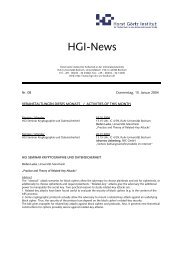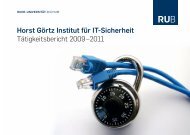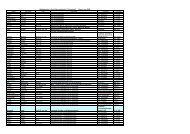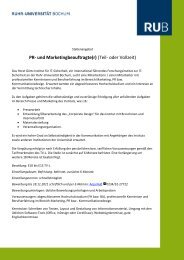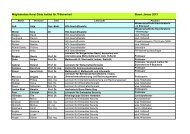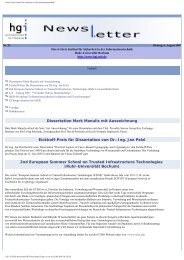A Family of Light-Weight Block Ciphers Based on DES Suited for ...
A Family of Light-Weight Block Ciphers Based on DES Suited for ...
A Family of Light-Weight Block Ciphers Based on DES Suited for ...
You also want an ePaper? Increase the reach of your titles
YUMPU automatically turns print PDFs into web optimized ePapers that Google loves.
A <str<strong>on</strong>g>Family</str<strong>on</strong>g> <str<strong>on</strong>g>of</str<strong>on</strong>g> <str<strong>on</strong>g>Light</str<strong>on</strong>g>-<str<strong>on</strong>g>Weight</str<strong>on</strong>g> <str<strong>on</strong>g>Block</str<strong>on</strong>g> <str<strong>on</strong>g>Ciphers</str<strong>on</strong>g> <str<strong>on</strong>g>Based</str<strong>on</strong>g> <strong>on</strong> <strong>DES</strong> <strong>Suited</strong> <strong>for</strong> RFID Applicati<strong>on</strong>s 11<br />
The 15 round approximati<strong>on</strong> is<br />
−AB − BA − AB − BA − AB<br />
If the number <str<strong>on</strong>g>of</str<strong>on</strong>g> S-boxes involved in the approximati<strong>on</strong> <str<strong>on</strong>g>of</str<strong>on</strong>g> A is a and <strong>for</strong> B is b we denote by<br />
A = (a, b). First assume that A = (1, 1). Due to Z 2 = Y 1 and the property <str<strong>on</strong>g>of</str<strong>on</strong>g> the P-permutati<strong>on</strong>,<br />
which distributes the output bits <str<strong>on</strong>g>of</str<strong>on</strong>g> <strong>on</strong>e S-box to 6 different S-Boxes in the next round, it must<br />
hold that |Y 1 | = |Z 2 | = 1. For the same reas<strong>on</strong> we get |Z 1 | = |Y 2 | = 1. To minimize the probability<br />
<str<strong>on</strong>g>of</str<strong>on</strong>g> such an approximati<strong>on</strong> we stipulate the following c<strong>on</strong>diti<strong>on</strong><br />
C<strong>on</strong>diti<strong>on</strong> 3 The S-box has to fulfill S W b (a) ≤ 4 <strong>for</strong> all a ∈ GF(2)6 , b ∈ GF(2) 4 with wt(a) =<br />
wt(b) = 1.<br />
This c<strong>on</strong>diti<strong>on</strong> is comparable to C<strong>on</strong>diti<strong>on</strong> 4 in [KLPL95], however, as we <strong>on</strong>ly have a single S-box,<br />
we could not find a single S-box fulfilling all the restricti<strong>on</strong>s from c<strong>on</strong>diti<strong>on</strong> 4 in [KLPL95]. If the<br />
S-box fulfils c<strong>on</strong>diti<strong>on</strong> 3 the overall bias <strong>for</strong> the linear approximati<strong>on</strong> described above is bounded<br />
by<br />
( ) 10 4<br />
ε ≤ 2 9 < 2 −40 .<br />
128<br />
As this is (much) smaller than 2 −28 this does not yield to a useful approximati<strong>on</strong>.<br />
Assume now that A = (1, 2) (the case A = (2, 1) is very similar). If B involves two S-boxes<br />
we have |Y 1 | = |Y 2 | = 2 and thus |Y 2 | = |Z 1 | = 2. In particular <strong>for</strong> both S-boxes involved in B<br />
C<strong>on</strong>diti<strong>on</strong> 3 applies which results in a threshold<br />
) 5<br />
< 2 −46<br />
ε ≤ 2 14 ( 4<br />
128<br />
) 10 ( 28<br />
128<br />
<strong>for</strong> the overall linear bias.<br />
Next we assume that A = (2, 2) . In this case we get (through the properties <str<strong>on</strong>g>of</str<strong>on</strong>g> the P functi<strong>on</strong>)<br />
that each S-box involved in A and B has at most two input and output bits involved in the linear<br />
approximati<strong>on</strong>. In order to avoid this kind <str<strong>on</strong>g>of</str<strong>on</strong>g> approximati<strong>on</strong> we add another c<strong>on</strong>diti<strong>on</strong>.<br />
C<strong>on</strong>diti<strong>on</strong> 4 The S-box has to fulfill Sb<br />
W(a) ≤ 16 <strong>for</strong> all a ∈ GF(2)6 , b ∈ GF(2) 4 with wt(a), wt(b) ≤<br />
2.<br />
This c<strong>on</strong>diti<strong>on</strong> is a tightened versi<strong>on</strong> <str<strong>on</strong>g>of</str<strong>on</strong>g> C<strong>on</strong>diti<strong>on</strong> 5 in [KLPL95] where the threshold was set to 20<br />
. In this case (remember that we now have 20 S-boxes involved) we get<br />
( ) 20 16<br />
ε ≤ 2 19 < 2 −40 .<br />
128<br />
In all other cases, more than 23 S-boxes involved and thus the general upper bound (3) can be<br />
applied.<br />
5.4 5R Iterative Linear Approximati<strong>on</strong><br />
A five round iterative linear approximati<strong>on</strong> c<strong>on</strong>sists <str<strong>on</strong>g>of</str<strong>on</strong>g> three linear approximati<strong>on</strong>s <strong>for</strong> the F functi<strong>on</strong><br />
<str<strong>on</strong>g>of</str<strong>on</strong>g> the sec<strong>on</strong>d, third and fourth round. We denote these approximati<strong>on</strong>s as<br />
A : 〈I 2 , Z 1 〉 + 〈K 2 , Z 3 〉 = 〈O 2 , Z 2 〉<br />
B : 〈I 3 , Y 1 〉 + 〈K 3 , Y 3 〉 = 〈O 3 , Y 2 〉<br />
C : 〈I 4 , X 1 〉 + 〈K 4 , X 3 〉 = 〈O 4 , X 2 〉.




